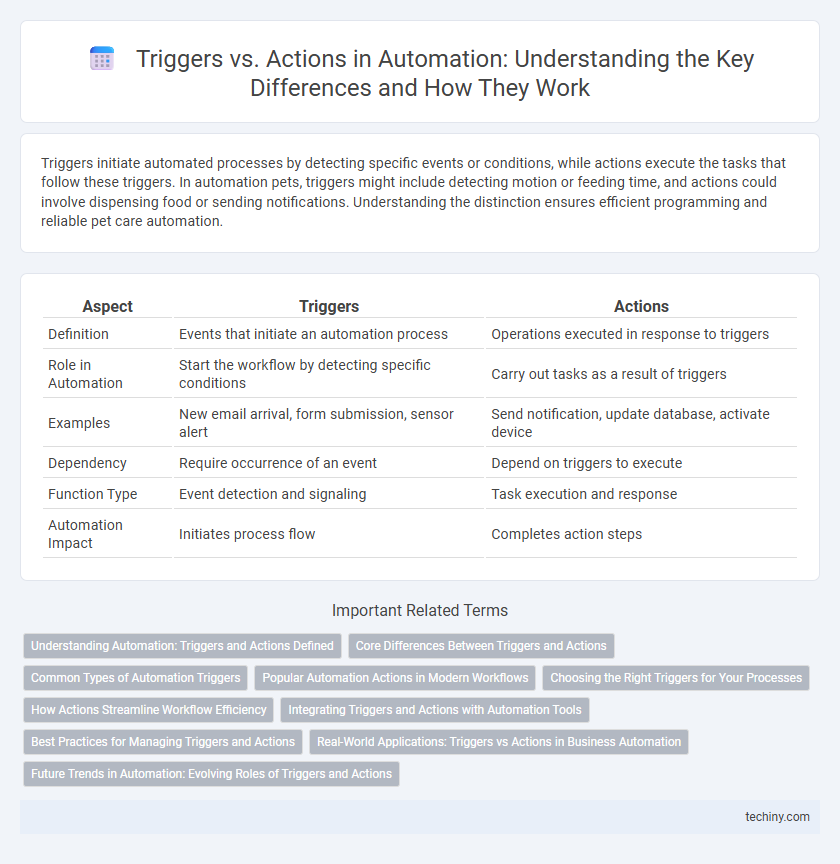Triggers initiate automated processes by detecting specific events or conditions, while actions execute the tasks that follow these triggers. In automation pets, triggers might include detecting motion or feeding time, and actions could involve dispensing food or sending notifications. Understanding the distinction ensures efficient programming and reliable pet care automation.
Table of Comparison
| Aspect | Triggers | Actions |
|---|---|---|
| Definition | Events that initiate an automation process | Operations executed in response to triggers |
| Role in Automation | Start the workflow by detecting specific conditions | Carry out tasks as a result of triggers |
| Examples | New email arrival, form submission, sensor alert | Send notification, update database, activate device |
| Dependency | Require occurrence of an event | Depend on triggers to execute |
| Function Type | Event detection and signaling | Task execution and response |
| Automation Impact | Initiates process flow | Completes action steps |
Understanding Automation: Triggers and Actions Defined
Triggers initiate automated processes by detecting specific events or conditions, such as receiving an email or a change in data status. Actions are the tasks executed automatically in response to triggers, like sending notifications or updating records in a system. Clear understanding of triggers and actions is essential for designing efficient automation workflows that save time and reduce manual effort.
Core Differences Between Triggers and Actions
Triggers initiate automation workflows by detecting specific events or conditions within a system, such as receiving an email or a device temperature reaching a threshold. Actions are the subsequent tasks executed automatically in response to triggers, like sending notifications, updating databases, or activating devices. The core difference lies in triggers serving as the starting point for automation, while actions represent the operational responses designed to achieve desired outcomes.
Common Types of Automation Triggers
Common types of automation triggers include time-based triggers, event-based triggers, and condition-based triggers, each serving distinct purposes in workflow automation. Time-based triggers activate processes at specific intervals or scheduled times, ensuring timely task execution. Event-based triggers respond to particular occurrences such as receiving an email or user actions, while condition-based triggers initiate workflows when predefined criteria or data thresholds are met.
Popular Automation Actions in Modern Workflows
Popular automation actions in modern workflows include sending notifications, updating records, and creating tasks. Triggers such as email receipt, form submissions, or status changes initiate these actions to streamline processes. Leveraging these triggers and actions enhances efficiency by reducing manual intervention and accelerating task completion.
Choosing the Right Triggers for Your Processes
Selecting the right triggers for your automation processes significantly enhances workflow efficiency and accuracy by initiating actions based on precise conditions or events. Effective triggers include time-based schedules, specific user interactions, or system events that align closely with process goals to minimize unnecessary executions. Prioritizing triggers that reflect real-time data changes ensures timely responses and optimizes overall automation performance.
How Actions Streamline Workflow Efficiency
Actions in automation directly execute predefined tasks once triggers detect specific events, significantly streamlining workflow efficiency by reducing manual intervention. By automating repetitive tasks such as data entry, notifications, and system updates, actions minimize errors and accelerate process completion times. This seamless integration of actions within automation platforms optimizes resource allocation and enhances overall productivity across business operations.
Integrating Triggers and Actions with Automation Tools
Integrating triggers and actions with automation tools streamlines workflows by enabling precise event-driven responses that reduce manual intervention. Triggers detect specific conditions or events, while actions execute predefined tasks, creating seamless automation sequences across platforms like Zapier, Microsoft Power Automate, and IFTTT. Optimizing this integration enhances operational efficiency, improves task accuracy, and enables scalable automation strategies for businesses.
Best Practices for Managing Triggers and Actions
Effective management of triggers and actions in automation requires clearly defining trigger conditions to minimize false positives and ensure timely responses. Prioritize using specific, measurable triggers paired with precise actions to maintain workflow efficiency and prevent unintended outcomes. Regularly monitoring and testing trigger-action pairs helps optimize performance and adapt to changing operational needs.
Real-World Applications: Triggers vs Actions in Business Automation
Triggers initiate automated workflows by detecting specific events such as new customer orders, payment confirmations, or inventory level changes, enabling businesses to respond instantly. Actions are the subsequent tasks performed automatically, including sending emails, updating CRM records, or adjusting stock quantities to maintain operational efficiency. Implementing precise triggers and tailored actions in business automation optimizes processes, reduces errors, and accelerates decision-making.
Future Trends in Automation: Evolving Roles of Triggers and Actions
Future trends in automation highlight a shift where triggers evolve from simple event detectors to intelligent, context-aware sensors using AI and machine learning. Actions are becoming increasingly adaptive, leveraging real-time data analytics to execute dynamic and predictive responses across integrated systems. The convergence of triggers and actions with IoT and edge computing is driving hyper-personalized automation workflows, enhancing efficiency and responsiveness in complex environments.
Triggers vs Actions Infographic

 techiny.com
techiny.com